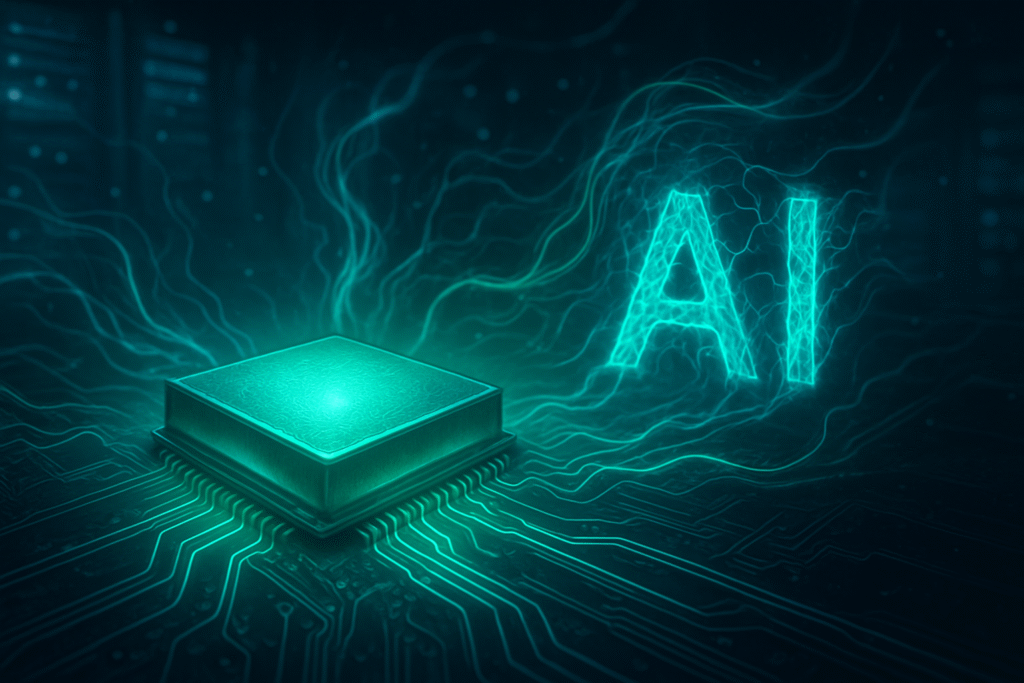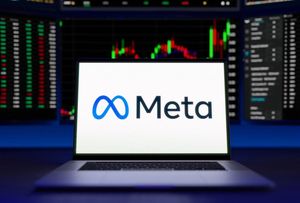
Navitas Semiconductor (NASDAQ: NVTS) has experienced an extraordinary surge in its stock value, driven by intense "AI chip buzz" surrounding its advanced Gallium Nitride (GaN) and Silicon Carbide (SiC) power technologies. The company's recent announcements, particularly its strategic partnership with NVIDIA (NASDAQ: NVDA) to power next-generation AI data centers, have positioned Navitas as a critical enabler in the escalating AI revolution. This rally, which saw Navitas shares soar by as much as 36% in after-hours trading and over 520% year-to-date by mid-October 2025, underscores a pivotal shift in the AI hardware landscape, where efficient power delivery is becoming as crucial as raw processing power.
The immediate significance of this development lies in Navitas's ability to address the fundamental power bottlenecks threatening to impede AI's exponential growth. As AI models become more complex and computationally intensive, the demand for clean, efficient, and high-density power solutions has skyrocketed. Navitas's wide-bandgap (WBG) semiconductors are engineered to meet these demands, enabling the transition to transformative 800V DC power architectures within AI data centers, a move far beyond legacy 54V systems. This technological leap is not merely an incremental improvement but a foundational change, promising to unlock unprecedented scalability and sustainability for the AI industry.
The GaN Advantage: Revolutionizing AI Power Delivery
Navitas Semiconductor's core innovation lies in its proprietary Gallium Nitride (GaN) technology, often complemented by Silicon Carbide (SiC) solutions. These wide bandgap materials offer profound advantages over traditional silicon, particularly for the demanding requirements of AI data centers. Unlike silicon, GaN possesses a wider bandgap, enabling devices to operate at higher voltages and temperatures while switching up to 100 times faster. This dramatically reduces switching losses, allowing for much higher switching frequencies and the use of smaller, more efficient passive components.
For AI data centers, these technical distinctions translate into tangible benefits: GaN devices exhibit ultra-low resistance and capacitance, minimizing energy losses and boosting efficiency to over 98% in power conversion stages. This leads to a significant reduction in energy consumption and heat generation, thereby cutting operational costs and reducing cooling requirements. Navitas's GaNFast power ICs and GaNSense
power ICs and GaNSense technology integrate GaN power FETs with essential control, drive, sensing, and protection circuitry on a single chip. Key offerings include a new 100V GaN FET portfolio optimized for lower-voltage DC-DC stages on GPU power boards, and 650V GaN devices with GaNSafe
technology integrate GaN power FETs with essential control, drive, sensing, and protection circuitry on a single chip. Key offerings include a new 100V GaN FET portfolio optimized for lower-voltage DC-DC stages on GPU power boards, and 650V GaN devices with GaNSafe protection, facilitating the migration to 800V DC AI factory architectures. The company has already demonstrated a 3.2kW data center power platform with over 100W/in³ power density and 96.5% efficiency, with plans for 4.5kW and 8-10kW platforms by late 2024.
protection, facilitating the migration to 800V DC AI factory architectures. The company has already demonstrated a 3.2kW data center power platform with over 100W/in³ power density and 96.5% efficiency, with plans for 4.5kW and 8-10kW platforms by late 2024.
Initial reactions from the AI research community and industry experts have been overwhelmingly positive. The collaboration with NVIDIA (NASDAQ: NVDA) has been hailed as a pivotal moment, addressing the critical challenge of delivering immense, clean power to AI accelerators. Experts emphasize Navitas's role in solving AI's impending "power crisis," stating that without such advancements, data centers could literally run out of power, hindering AI's exponential growth. The integration of GaN is viewed as a foundational shift towards sustainability and scalability, significantly mitigating the carbon footprint of AI data centers by cutting energy losses by up to 30% and tripling power density. This market validation underscores Navitas's strategic importance as a leader in next-generation power semiconductors and a key enabler for the future of AI hardware.
Reshaping the AI Industry: Competitive Dynamics and Market Disruption
Navitas Semiconductor's GaN technology is poised to profoundly impact the competitive landscape for AI companies, tech giants, and startups. Companies heavily invested in high-performance computing, such as NVIDIA (NASDAQ: NVDA), Alphabet (NASDAQ: GOOGL), Microsoft (NASDAQ: MSFT), Amazon (NASDAQ: AMZN), and Meta (NASDAQ: META), which are all developing vast AI infrastructures, stand to benefit immensely. By adopting Navitas's GaN solutions, these tech giants can achieve enhanced power efficiency, reduced cooling needs, and smaller hardware form factors, leading to increased computational density and lower operational costs. This translates directly into a significant strategic advantage in the race to build and deploy advanced AI.
Conversely, companies that lag in integrating advanced GaN technologies risk falling behind in critical performance and efficiency metrics. This could disrupt existing product lines that rely on less efficient silicon-based power management, creating a competitive disadvantage. AI hardware manufacturers, particularly those designing AI accelerators, portable AI platforms, and edge inference chips, will find GaN indispensable for creating lighter, cooler, and more energy-efficient designs. Startups focused on innovative power solutions or compact AI hardware will also benefit, using Navitas's integrated GaN ICs as essential building blocks to bring more efficient and powerful products to market faster.
The potential for disruption is substantial. GaN is actively displacing traditional silicon-based power electronics in high-performance AI applications, as silicon reaches its limits in meeting the demands for high-current, stable power delivery with minimal heat generation. The shift to 800V DC data center architectures, spearheaded by companies like NVIDIA (NASDAQ: NVDA) and enabled by GaN/SiC, is a revolutionary step up from legacy 48V systems. This allows for over 150% more power transport with the same amount of copper, drastically improving energy efficiency and scalability. Navitas's strategic advantage lies in its pure-play focus on wide-bandgap semiconductors, its strong patent portfolio, and its integrated GaN/SiC offerings, positioning it as a leader in a market projected to reach $2.6 billion by 2030 for AI data centers alone. Its partnership with NVIDIA (NASDAQ: NVDA) further solidifies its market position, validating its technology and securing its role in high-growth AI sectors.
Wider Significance: Powering AI's Sustainable Future
Navitas Semiconductor's GaN technology represents a critical enabler in the broader AI landscape, addressing one of the most pressing challenges facing the industry: escalating energy consumption. As AI processor power consumption is projected to increase tenfold from 7 GW in 2023 to over 70 GW by 2030, efficient power solutions are not just an advantage but a necessity. Navitas's GaN solutions facilitate the industry's transition to higher voltage architectures like 800V DC systems, which are becoming standard for next-generation AI data centers. This innovation directly tackles the "skyrocketing energy requirements" of AI, making GaN a "game-changing semiconductor material" for energy efficiency and decarbonization in AI data centers.
The overall impacts on the AI industry and society are profound. For the AI industry, GaN enables enhanced power efficiency and density, leading to more powerful, compact, and energy-efficient AI hardware. This translates into reduced operational costs for hyperscalers and data center operators, decreased cooling requirements, and a significantly lower total cost of ownership (TCO). By resolving critical power bottlenecks, GaN technology accelerates AI model training times and enables the development of even larger and more capable AI models. On a societal level, a primary benefit is its contribution to environmental sustainability. Its inherent efficiency significantly reduces energy waste and the carbon footprint of electronic devices and large-scale systems, making AI a more sustainable technology in the long run.
Despite these substantial benefits, challenges persist. While GaN improves efficiency, the sheer scale of AI's energy demand remains a significant concern, with some estimates suggesting AI could consume nearly half of all data center energy by 2030. Cost and scalability are also factors, though Navitas is addressing these through partnerships for 200mm GaN-on-Si wafer production. The company's own financial performance, including reported unprofitability in Q2 2025 despite rapid growth, and geopolitical risks related to production facilities, also pose concerns. In terms of its enabling role, Navitas's GaN technology is akin to past hardware breakthroughs like NVIDIA's (NASDAQ: NVDA) introduction of GPUs with CUDA in 2006. Just as GPUs enabled the growth of neural networks by accelerating computation, GaN is providing the "essential hardware backbone" for AI's continued exponential growth by efficiently powering increasingly demanding AI systems, solving a "fundamental power bottleneck that threatened to slow progress."
The Horizon: Future Developments and Expert Predictions
The future of Navitas Semiconductor's GaN technology in AI promises continued innovation and expansion. In the near term, Navitas is focused on rapidly scaling its power platforms to meet the surging AI demand. This includes the introduction of 4.5kW platforms combining GaN and SiC, pushing power densities over 130W/in³ and efficiencies above 97%, with plans for 8-10kW platforms by the end of 2024 to support 2025 AI power requirements. The company is also advancing its 800 VDC power devices for NVIDIA's (NASDAQ: NVDA) next-generation AI factory computing platforms and expanding manufacturing capabilities through a partnership with Powerchip Semiconductor Manufacturing Corp (PSMC) for 200mm GaN-on-Si wafer production, with initial 100V family production expected in the first half of 2026.
Long-term developments include deeper integration of GaN with advanced sensing and control features, leading to smarter and more autonomous power management units. Navitas aims to enable 100x more server rack power capacity by 2030, supporting exascale computing infrastructure. Beyond data centers, GaN and SiC technologies are expected to be transformative for electric vehicles (EVs), solar inverters, energy storage systems, next-generation robotics, and high-frequency communications. Potential applications include powering GPU boards and the entire data center infrastructure from grid to GPU, enhancing EV charging and range, and improving efficiency in consumer electronics.
Challenges that need to be addressed include securing continuous capital funding for growth, further market education about GaN's benefits, optimizing cost and scalability for high-volume manufacturing, and addressing technical integration complexities. Experts are largely optimistic, predicting exponential market growth for GaN power devices, with Navitas maintaining a leading position. Wide bandgap semiconductors are expected to become the standard for high-power, high-efficiency applications, with the market potentially reaching $26 billion by 2030. Analysts view Navitas's GaN solutions as providing the essential hardware backbone for AI's continued exponential growth, making it more powerful, compact, and energy-efficient, and significantly reducing AI's environmental footprint. The partnership with NVIDIA (NASDAQ: NVDA) is expected to deepen, leading to continuous innovation in power architectures and wide bandbandgap device integration.
A New Era of AI Infrastructure: Comprehensive Wrap-up
Navitas Semiconductor's (NASDAQ: NVTS) stock surge is a clear indicator of the market's recognition of its pivotal role in the AI revolution. The company's innovative Gallium Nitride (GaN) and Silicon Carbide (SiC) power technologies are not merely incremental improvements but foundational advancements that are reshaping the very infrastructure upon which advanced AI operates. By enabling higher power efficiency, greater power density, and superior thermal management, Navitas is directly addressing the critical power bottlenecks that threaten to limit AI's exponential growth. Its strategic partnership with NVIDIA (NASDAQ: NVDA) to power 800V DC AI factory architectures underscores the significance of this technological shift, validating GaN as a game-changing material for sustainable and scalable AI.
This development marks a crucial juncture in AI history, akin to past hardware breakthroughs that unleashed new waves of innovation. Without efficient power delivery, even the most powerful AI chips would be constrained. Navitas's contributions are making AI not only more powerful but also more environmentally sustainable, by significantly reducing the carbon footprint of increasingly energy-intensive AI data centers. The long-term impact could see GaN and SiC becoming the industry standard for power delivery in high-performance computing, solidifying Navitas's position as a critical infrastructure provider across AI, EVs, and renewable energy sectors.
In the coming weeks and months, investors and industry observers should closely watch for concrete announcements regarding NVIDIA (NASDAQ: NVDA) design wins and orders, which will validate current market valuations. Navitas's financial performance and guidance will provide crucial insights into its ability to scale and achieve profitability in this high-growth phase. The competitive landscape in the wide-bandgap semiconductor market, as well as updates on Navitas's manufacturing capabilities, particularly the transition to 8-inch wafers, will also be key indicators. Finally, the broader industry's adoption rate of 800V DC architectures in data centers will be a testament to the enduring impact of Navitas's innovations. The leadership of Chris Allexandre, who assumed the role of President and CEO on September 1, 2025, will also be critical in navigating this transformative period.
This content is intended for informational purposes only and represents analysis of current AI developments.
TokenRing AI delivers enterprise-grade solutions for multi-agent AI workflow orchestration, AI-powered development tools, and seamless remote collaboration platforms.
For more information, visit https://www.tokenring.ai/.








